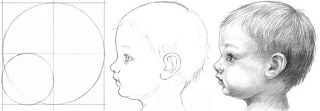How many times have you tried to draw a person, and finally given up in frustration saying ?I can?t get this right?? Be patient with yourself and don?t give up! Mastering figure drawing may take several years; however, with practice, your skills gradually improve and your drawings of people begin to look better and better.
Thursday, March 24, 2011
Sketching Figures with Lines
Rough, gesture, or action sketches are usually rendered very quickly, sometimes in less than a minute. The benefits of making rough sketches are in the process, rather than the creation of a magnificent work of art. Hence, you only goal is to capture a mood, expression or gesture on your drawing paper.
Tuesday, March 15, 2011
Friday, March 11, 2011
Tulip
Tulips are among the most beautiful flowers and are also quite easy to draw. In this project, you use slightly curved hatching lines of various values and lengths to draw a tulip, as well as a section of its stem and leaf.Detailed step-by-step instructions take you through every aspect of setting up proportions, establishing the shape of the individual parts, and adding shading to create depth.
Serene Scene
Sketching is an action word, and you can only learn this skill by actually sketching. To give you a feel for the sketching process, numerous illustrations and simple text take you step-by -step through the process of rendering a sketch from one of my sketches (much easier than working from an actual scene).
Graduated Values
Graduations are the primary ingredient in realistic shading. Hatching graduations are rendered by varying the density of lines, varying the pressure used in holding pencils, and/or using different pencils. The main goal is to keep the transition between the different values flowing into one another as smoothly as possible.
Playing With Pencils
Many artists struggle unnecessarily for years to create a full range of values with only one or two pencils, totally unaware of how pencils themselves can create different values. In this lesson, you create the illusion of depth in a mountain range, by using various grades of pencils. You will also utilize two components of perspective, overlapping and atmospheric perspective.
Monday, March 7, 2011
The Magic Ellipse by Cindy Wider
This lesson takes you step-by-step through the process of drawing an ellipse. You then use your ellipse drawing skills to render a drinking cup and a cookie jar.The ellipse is by far the most magical of all shapes. For example, ellipses can be added to the top and bottom of a straight sided shape to become a drinking cup.
Basic Perspective for Beginners
Perspective is the very foundation, on which your drawing compositions will either stand or fall. With proper use of perspective, your representational drawings become visually correct and more realistic. Understanding the rules of perspective can even enhance your creative skills, by allowing you the confidence to explore new concepts in depth perception in your drawings.
Wednesday, February 23, 2011
Squirkling a Bumpy Texture
In the real world, very few objects have actual lines defining their forms. Rather, contrasting values identify the edges of the object’s parts according to the lights and darks created by the dominant light source. This lesson focuses on values and forms rather than lines and shapes. You use squirkles to draw the wonderful bumpy texture of an avocado with shading only – no outlining.
Spruce Tree
In ten simple steps, you use squirkles to transform a single vertical line on a sheet of paper, into a drawing of a majestic spruce tree. With lots of practice using squirkles and examining spruce trees in nature, you can easily learn to sketch a tree in a couple of minutes (or less). However, you need to work your way slowly through this exercise to give yourself a chance to fully understand the process.
Graduating Squirkles
In this lesson you explore squirkle shading in drawings and then render graduated values with squirkles. By varying the density (drawing the lines either far apart or close together) of the lines, you can achieve many different values. Light values tend to have noticeable curved lines with lots of white space showing. In darker values, the lines are drawn more closely together, filling in most of the paper with squirkles.
Wednesday, February 16, 2011
Allie Alligator
Learning to see as an artist is the very foundation of drawing. A thorough visual examination of your subject is the most important ingredient for making great sketches. This lesson challenges you to rely completely on your visual skills rather than verbal instructions. Thirty illustrations take you through the process of combining lines with shapes to create a cartoon drawing of an alligator.
Starr Fish
Twenty-three illustrations take you through the process of enhancing your visiual skills while creating a cartoon drawing of a starfish named Starr Fish. Various beginner drawing skills are utilized including sketching accurate proportions, combining lines to make shapes, and adding details with lines and circular shapes.
Subscribe to:
Posts (Atom)















































